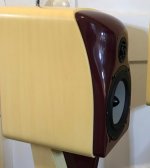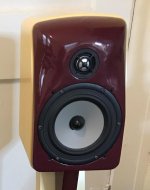Not sure if this was a serious suggestion but what would you do about diffraction off the frame of the midrange? Given the rule of thumb that sound needs to pass through about a quarter of a wavelength of foam to be absorbed effectively how would you prevent sound taking a short cut out the sides/forward and not being absorbed?
The post is asking for shape, I'm on the fence about whether or not size is included in shape or a separate aspect completely. Never the less, consider that, the widest baffles, provide the best imaging. The wider the baffle, the less important the shape.
I find it fascinating that a lot of speaker performance metrics I would consider to be solved in a way and largely quantifiable but I haven't really seen much of a consensus on what makes a speaker have good sound stage. Imaging seems to be kinda easy for almost any speaker, I haven't run into a speaker where I couldn't place elements left, center, and right, but creating a stage for the elements to sit in seems tougher.
While subjective, I'm not sure how subjective it really is. Most of my non-audio and semi-audio enthusiast friends would agree on hearing the same things as far as sound stage and imaging goes with speakers I've shared with them. Often they will ask me if they would even appreciate the differences between low fidelity audio reproduction and higher fidelity and I just show them both. Even 'untrained' listeners seem to be quite good at identifying differences.
I think edge diffraction is kind of an important thing here. I'm dealing with a speaker atm that is leaving me disappointed and it has hard edges on the baffle. I swear if I'm in the right spot near them, I can hear the edge that is closer to the driver as a secondary sound source. So it's probably best to minimize diffraction, probably a reason for a lot of high performance speakers pursue fixing that problem.
So far my favoraite speaker as far as sound stage and imaging goes were the Behringer 2030p. I kinda wish they still make them in a passive model because the actives have a different internal volume (I asked behringer and they kinda lied to me about it, if you have both in hand it's obvious one has reduced internal volume). The amp is also kinda junk, pops hard on power on and off.
If you check the ASR review you can see this speaker has surprisingly good dispersion.
https://www.audiosciencereview.com/...behringer-b2030p-studio-monitor-review.14719/
So my belief right is now that having smooth dispersion and minimal diffraction effects are the key to great imaging and sound stage.
I also think there needs to be some talk on what a wide baffle is. Seems it's mostly anything wider than your typical 7-8" bookshelf speaker baffle. I'd argue it should be defined as narrow, medium, and wide, or something of the like. I think speakers in the medium width baffle area the least forgiving reguiring hefty round overs.
Troels Gravesen would appear to think differently.Many of his designs have wide/widish baffles and most of them have square cabinet edges.He is even placing tweeters right in the middle of these flat wide baffles.Which is probably where they should be if you are trying to achieve efficiency.His most popular recent designs are like that and are reputed to have very good imaging.
Troels also says stuff like sealed mid range kill mid range quality, and then designs several speakers with closed mid ranges...
I always thought my NHT XDSs had really nice imaging and a smooth room response... enjoyed them for awhile then moved on to something different and are now in storage. Maybe I should dig them back out one of these days...
Attachments
I haven’t seen the loudspeaker in the chair-review video here before (left rear corner of room-scene), but the shape seems quite good:
Considering the wider the baffle, the better imaging.I believe wide baffles have been wrongly blamed for poor imaging.Association is not cause..
"I haven't really seen much of a consensus on what makes a speaker have good sound stage. Imaging seems to be kinda easy for almost" - the diminishing of diffraction via smooth transitioning baffles and/or large baffles pushing the interaction into the lower larger frequencies, high DI to diminish side wall reflections that blur the image/soundstage.... equilateral listening triangle... phase alignment... other things that lead to a better IR at the listening position and off axis.
Yeah, some of the best 'stereo' I've experienced was with mono in a highly reflective room.In the old days (when British hifi magazines still had some critical reviews), they used to say mono listening was a good torture test for revealing a speaker's true characteristics.
Well, if the driver's BW is smaller or much larger than the baffle, then sharp corners are ~moot and the center is an eigenmode fundamental null, so if the driver and/or summed XO has a peak at ~ this frequency........ seems like a good design to me. 😉Troels Gravesen would appear to think differently.Many of his designs have wide/widish baffles and most of them have square cabinet edges.He is even placing tweeters right in the middle of these flat wide baffles.Which is probably where they should be if you are trying to achieve efficiency.His most popular recent designs are like that and are reputed to have very good imaging.
I would say that the worst baffle-width for an ordinary box-shaped speaker with "sharp" edges is either the average ear-to-ear distance or twice that much.
Regards
Charles
Regards
Charles
There should be more YT clips to learn about making such clean bevels...I am not convinced by the wood cisel method.
In germany we have one shop that offer acoustic foam rods in 2inch diameter and 100cm long :
https://www.schaumstofflager.de/run...ge-100cm-durchmesser-5cm-anthrazit-weich.html
https://www.panasorb.eu/index.php?language=en
Cut them along the length in halve using razorblades , add some some double sticky strips and you have a nice attractive 180deg roundover for positioning at any sharp baffle edge!
Or use iron paint with hidden magnets to get a more comfortable situation .
Many Options!
https://www.schaumstofflager.de/run...ge-100cm-durchmesser-5cm-anthrazit-weich.html
https://www.panasorb.eu/index.php?language=en
Cut them along the length in halve using razorblades , add some some double sticky strips and you have a nice attractive 180deg roundover for positioning at any sharp baffle edge!
Or use iron paint with hidden magnets to get a more comfortable situation .
Many Options!
^ Hi,
1" radius shows effect perhaps down to 4" wavelength. If baffle is bigger than 4", for example 8", then diffraction related secondary sound source at the edge extend octave lower in frequency than the radius has any effect on.
So you'd need perhaps 2" radius round over, which further widens the baffle if implemented as after thought as extra size for the baffle. Any radius is good, as long as it starts immediately next to transducer. This way the radius stays relevant for all the bandwidth the edge makes sound source for. In other words, any flat area between transducer and start of edge relief reduces effectiveness of the relief.
Well, if any of it is audible in the first place.
1" radius shows effect perhaps down to 4" wavelength. If baffle is bigger than 4", for example 8", then diffraction related secondary sound source at the edge extend octave lower in frequency than the radius has any effect on.
So you'd need perhaps 2" radius round over, which further widens the baffle if implemented as after thought as extra size for the baffle. Any radius is good, as long as it starts immediately next to transducer. This way the radius stays relevant for all the bandwidth the edge makes sound source for. In other words, any flat area between transducer and start of edge relief reduces effectiveness of the relief.
Well, if any of it is audible in the first place.
Last edited:
I assume you measure two cabinets with 2 shapes either on and off axis and compare power responses ?!
Last edited:
Single measurement (spinorama), and one can read diffraction from interference pattern. Make simulation and compare.
If it was ideal point source frequency response to any direction would be smooth, no wiggle whatsoever. As soon as you have wiggle in your frequency response graph it means shows there is at least one more spund source, the wiggle is due to interference. And interference pattern reveals delay and amplitude and bandwidth, at least approximation. One can make simulation with ideal case without any measurement error or doubt, and compare measurements to it.
Interference pattern is like a fingerprint.
If it was ideal point source frequency response to any direction would be smooth, no wiggle whatsoever. As soon as you have wiggle in your frequency response graph it means shows there is at least one more spund source, the wiggle is due to interference. And interference pattern reveals delay and amplitude and bandwidth, at least approximation. One can make simulation with ideal case without any measurement error or doubt, and compare measurements to it.
Interference pattern is like a fingerprint.
Last edited:
And what in terms of the whole cabinet? The thread is about the cabinet, not the baffle only. You would object that the baffle is where 'the sound leaves the speaker' so the game is there, but it isn't. The cabinet reflects ( and diffracts and refracts) the sound that bounces from all over so it become a ghost source, or better, many sources. How would you compute that ?
Thread got me trying some thing with materials left over. I call these the Grub LS-420/69.

- Home
- Loudspeakers
- Multi-Way
- Which shape of cabinet gives a better image?

